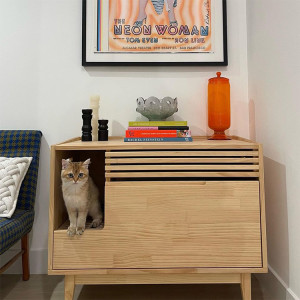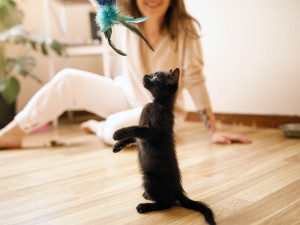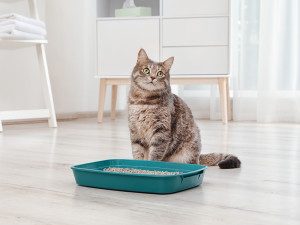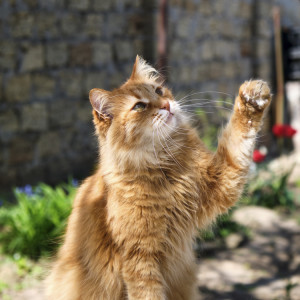How to Train a Cat to Use a Litter Box
If you do nothing else, teach your cat to poop in their litter box (not your shoe).

Share Article
In This Article:
Cat Litter Box Training Tips How to Litter Train a Kitten Fast Training Adult Cats and Strays Why Won’t My Cat Use the Litter Box?
Potty training for cats is pretty important (OK, that’s an understatement), so setting up a litter box and making sure your cat knows where to do their business should be the first step in cat parenthood. Fortunately, potty training cats is pretty simple. “There’s not a lot of training required,” says Washington State University School of Veterinary Medicine professor Dr. Jessica Bell.
Cat litter box training tips
For those cats who don’t pick up potty training right away, the inability to use a litter box can be extremely disruptive; it’s not cool for your cat to turn the potted plants or your favorite slippers into their toilet. It’s not ideal for your cat, either, who’s a huge fan of consistency and just wants to do their business in peace. Below are some cat litter box training tips to keep you and your cat both happy.
Choosing the right litter box
Deciding which litter box to pick from the myriad options at the pet store can be complicated. There are different types of cat litter boxes with pros and cons: Big box? Little box? Covered box? Robot litter box? It depends, per Dr. Bell.

For kittens, she suggests starting with a smaller, shallow box that’s easier for kittens to climb into, then begin increasing the size as they grow. “Adult cats don’t like small, cramped litter boxes,” she says. “The bigger the cat, the bigger the box.” Some cats like covered boxes, while others prefer open boxes. You may have to try a few different options to see which one calls to your cat when they experience the call of nature.
Selecting the appropriate litter
Similar to choosing a litter box, there are also cat litter pros and cons. Thankfully, the results are in:
Scientists have actually researched litter preferencesopens in new tab and found that cats prefer clay litter to silica (sand) or wood pellets.
Steer clear of clumping and scented litters as both might make your cat avoid the litter box. “Cats have really sensitive noses and don’t like perfumed litter,” Dr. Bell says.
As for clumping, it’s a texture thing. “The clumping litter turns urine into hard balls and cats have to move these little rocks around to go to the bathroom.”
Make sure the litter is deep enough that your cat can bury their waste. It’ll improve the ambiance for everyone.
Litter box setup
You like your privacy when you pee and your cat does, too. Choose a quiet spot like the laundry room or bathroom for the litter box. This gives your cat a chance to relax without distractions like dogs running down the hall or roommates watching TikToks at full volume. Privacy is good, but don’t banish your cat to the basement to access the litter box. Dr. Bell notes that cats don’t want to expend too much energy trekking to the bathroom. The more hassle required to reach the box, the higher the likelihood your cat will find a “better” spot to go.
Maintaining litter box hygiene
Your cat does their part by doing their business in a box; it’s your job to keep it clean. Dr. Bell warns that cats will avoid dirty litter boxes and find other places to go to the bathroom. If you’d rather your kitty didn’t make unexpected deposits behind the couch because you failed to scoop their litter box, scoop it at least once a day and empty, scrub, and refill the entire litter box once a week.
How to litter train a kitten fast
Just how long does it take a kitten to litter train? Or to potty train a cat? Most kittens will use the litter box instinctively without any training at all, but some need a few days to get the hang of it. “Most cats easily adapt to a good, clean litter box,” Dr. Bell says.
However, some kittens do take several weeks to figure out how to use the litter box. Here are some tips for helping them learn to use their litter box fast.
Introduce the litter box early
You can start litter training your kitten as soon as you bring them home after they’re weaned — this is usually around three weeks of age.
Placing the kitten in the litter box after meals and naps
Your kitten will start to associate the litter box with doing their business if they’re put there when they naturally want to go — which is often after meals and naps, when their belly and bladder are full.
Positive reinforcement
No matter how badly you want to yell, “Noooo!” and snatch up your cat when you catch them going to the bathroom on your new rug, scolding them is not the answer. “You want to offer positive reinforcement,” Dr. Bell says. “If you scare them [when they have an accident], it’s not going to help them with litter box training — stress can cause even more litter box problems.”
Training adult cats and strays
When it comes to training adult cats, there are some special challenges and tricks.
Providing multiple litter box options
It’s best to provide multiple litter box options for adult cats, so they’re more likely to try one out that’s close to them — plus, with an extra box, they can always have a clean option if one is dirty. Try placing multiple boxes in different areas of the house.
Using attractants and pheromone sprays
Certain attractants and pheromone sprays can help attract cats to certain areas of the house by providing a calming effect. “They can also spot-treat problem areas, like furniture that cats are scratching or areas chosen for inappropriate urination,” veterinarian Dr. Alycia Washington wrote for us. “The sprays can quickly create a calming environment and mark objects as claimed (so your cat doesn’t feel the need to mark them).”
Confining the cat to a small space with the litter box
Confinement should be used if other options aren’t working, because it isn’t the most pleasant option for your cat. Keeping a cat in a small room with a litter box (along with everything necessary to be healthy and cozy, like food, water, and a bed) can help them learn faster that the litter box is the best place to do their business.
Gradually expanding the cat’s access to the home
After they’ve started using the litter box in their confined space, you can gradually expand the amount of space you let your cat explore. Hopefully, they’ll quickly figure out that they should return to the litter box when it’s time to go.
Why won’t my cat use the litter box?
Sh*t happens, right? When you’re trying to figure out why your cat is not using the litter box — and instead going to the bathroom outside the litter box — it may take some detective work to figure out what’s wrong.
Medical issues
Conditions like cat UTIs (urinary tract infections) or bladder stones can make your cat associate pain with their litter box, sending them to other spots to relieve themselves. If other options don’t work, make an appointment with your vet to rule out medical issues. Dr. Bell says clearing up the medical issue should stop the accidents.
Stress and anxiety
Stress and anxiety can cause cats to have accidents outside of the litter box. Look out for signs of cat anxiety and depression, and try experimenting with different cat calming products.
Aversion to litter type or box cleanliness
Nobody wants to step in their own waste the next time they go to the bathroom. Cats are pretty clean animals, and they won’t use a litter box that’s too dirty. Scoop often to encourage them to keep using the box.
Cats are also pretty finicky, so it’s possible they don’t like the kind of litter you’re using. Experiment with different types of litter if your cat’s refusing to use a clean litter box.
Territorial issues in multi-cat households
Cats often don’t like to share the litter box. Most animal experts will tell you that each cat should have their own litter box, plus one extra in the house. “If you start skimping on the number of litter boxes, you risk causing one or more of your cats to start eliminating outside the box,” cat behaviorist Stephen Quandt told us.
FAQs (People Also Ask):
How to train a cat to use a litter box?
It’s important to make sure your cat feels comfortable using their litter box, so put it in an accessible place where they can see their surroundings and make sure it’s kept clean. Use positive reinforcement when your cat uses the litter box. Introduce the box early and maintain good litter box hygiene.
What are the best litter boxes for kittens?
For kittens, Dr. Bell suggests starting with a smaller, shallow box that’s easier for kittens to climb into, then begin increasing the size as they grow. Different cats have different preferences for covered versus covered boxes.
Why won’t my cat use the litter box?
If your cat isn’t using their litter box, it’s likely because it doesn’t suit their preferences, or they have found another place they would rather relieve themselves.
References:
Greenville Humane Society Litter Training Your Cat/Kittenopens in new tab
Niles Animal Hospital Litter Box Training Your Cat opens in new tab
Humane Society of Missouri Kitten Behavior and Training - Litter Box Trainingopens in new tab
The Humane Society How to Help Your Cat Use the Litter Boxopens in new tab

Jodi Helmer
Jodi Helmer is a North Carolina-based freelance writer who shares her home with an embarrassing number of rescue dogs and relies on four feral cats to patrol the barn. When she isn’t refilling food and water dishes, Jodi writes about animals for Scientific American, Sierra, WebMD, AKC Family Dog, Living the Country Life, and Out Here.

Sio Hornbuckle
Sio Hornbuckle is the Assistant Editor at Kinship, where they frequently write for the site. As a writer, they specialize in pet news, animal science, and pop culture. They live in New York City with their cat, Toni Collette.
Related articles
![Red cat with squinted eyes laying in a basket closeup]()
6 Ways Your Cat Could Tell You They Are in Pain
Here are all the way your kitty is trying to tell you they’re hurting.
![Cat sitting by its litter box]()
Your Cat Can’t Poop—What Now?
Here’s how to deal with cat constipation.
Your Cat Is Limping. Now What?
When it’s no big deal and when you should worry.
![Small orange cat in wooden litter box.]()
9 Litter Box Enclosures That Aren’t Total Eyesores
Keep your cat’s litter box out of sight — but easy to scoop.
![Woman holding her black and white cat.]()
The Ultimate Shopping List for Your New Cat
It’s National Kitten Day! Here are all the new cat essentials you need, recommended by real pet parents.
![Cat eating out of a red bowl]()
Does Your Diabetic Cat Need a Special Diet?
Get ready for a sigh of relief — this food doesn’t have to be pricey.










